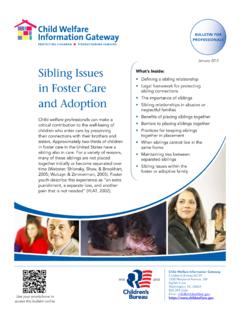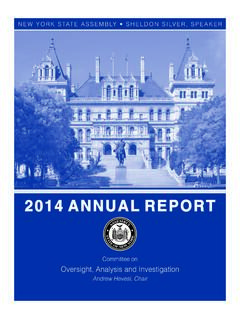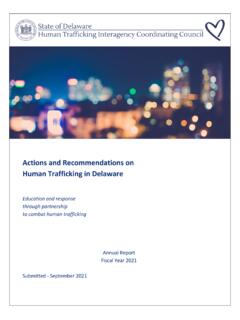Transcription of Substance Abuse and Child Maltreatment
1 Bulletin for professionals December 2003. Substance Abuse What's Inside: Impact of parental Substance Abuse and Child on children Service delivery issues Maltreatment Practice implications Implications Substance Abuse has a major impact on the Resources for further information Child welfare system. It is estimated that 9. percent of children in this country (6 million). live with at least one parent who abuses alcohol or other drugs (Office of Applied Studies, 2003). Research has demonstrated that children of Substance abusing parents are more likely to experience Abuse physi- cal, sexual, or emotional or neglect than children in non- Substance abusing households (DeBellis, Broussard, Herring, Wexler, Moritz, & Benitez, 2001; Dube, Anda, Felitti, Croft, Edwards, & Giles, 2001; Chaffin, Kelleher, & Hollenberg, 1996; Kelleher, Chaffin, Hollenberg, & Fischer, 1994). Child welfare Information Gateway Children's Bureau/ACYF.
2 Department of Health and Human Services 1250 Maryland Avenue, SW. Eighth Floor Administration for Children and Families Washington, DC 20024. Administration on Children, Youth and Families or Children's Bureau Email: Substance Abuse and Child Maltreatment Parents who Abuse substances are less likely to be able to function effectively in a parental Impact of Parental role. This can be due to: Substance Abuse on Impairments (both physical and mental) that occur while under the influence of alcohol Children or other drugs. Expenditure of often limited house- Maltreated children of Substance abusing hold resources on purchasing alcohol or parents are more likely to have poorer physi- other drugs. cal, intellectual, social, and emotional out- comes and are at greater risk of developing Time spent seeking out drugs. Substance Abuse problems themselves ( Department of Health and Human Services, Time spent using alcohol or other drugs.)
3 1999). Data indicate that abused or neglected The basic needs of children, including nutri- children from Substance abusing families are tion, supervision, and nurturing, often go more likely to be placed in foster care and are unmet due to parental Substance Abuse , more likely to remain there longer than mal- resulting in neglect. Additionally, families in treated children from non- Substance abusing which one or both parents Abuse substances, families ( Department of Health and and particularly families with an addicted Human Services, 1999). parent, often experience a number of other Because of the severity of problems experi- problems including mental illness, unemploy- enced by maltreated children of Substance ment, high levels of stress, and impaired family abusing parents, and the fact that they are functioning, all of which can put children at often in the foster care system longer than risk for Abuse .
4 Maltreated children from non- Substance The statistics vary, but studies have shown that abusing families, expenditures related to between one-third and two-thirds of Child mal- Substance Abuse among families in the Child treatment cases involve Substance Abuse ( welfare system are significant. One study esti- Department of Health and Human Services, mates that of the more than $24 billion states 1999). In a recent survey by the National spend to address different aspects of sub- Center on Child Abuse Prevention Research, stance Abuse , $ billion (slightly more than 85 percent of states reported Substance Abuse 20 percent) goes to Child welfare costs related was one of the two major problems exhib- to Substance Abuse (National Center on ited by families in which Maltreatment was Addiction and Substance Abuse at Columbia suspected (National Center on Child Abuse University, 2001).)
5 Prevention Research, 2001). This material may be freely reproduced and distributed. However, when doing so, please credit Child welfare . Information Gateway. Available online at Substance Abuse and Child Maltreatment Service Delivery Issues Practice Implications Along with the high cost of serving these Because so many Maltreatment cases involve families, Child welfare agencies often face a Substance Abuse , agencies are developing number of service barriers, such as: strategies to address the issue more effec- tively. All of these strategies require collabora- Inadequate treatment resources to meet tion among the various systems within which existing needs. affected families are involved ( , Child Lack of training for Child welfare workers on welfare , Substance Abuse , public assistance, Substance Abuse issues. and dependency court). Examples of innova- tive approaches include: Conflicts in the time required for sufficient progress in Substance Abuse recovery to Stationing addiction counselors in Child develop adequate parenting potential, welfare offices.
6 Legislative requirements regarding Child Giving mothers involved in the Child welfare permanency, and the developmental needs system priority access to Substance Abuse of children (Young & Gardner, 2003). treatment slots. Agencies are faced with strict timeframes Developing or modifying dependency imposed by the Adoption and Safe Families Act drug courts to ensure treatment access and of 1997 (ASFA) that do not necessarily coincide therapeutic monitoring of compliance with with the realities of Substance Abuse treatment. court orders. For example, despite a Federal mandate that pregnant and parenting women receive priority Developing cross-system partnerships to for accessing Substance Abuse treatment services, ensure coordinated services ( , formal states report it is often difficult for these parents linkages between Child welfare and other to access an open treatment slot quickly (GAO, community agencies to address each 2003).)
7 Once a slot is available, treatment itself family's needs). may take many months (some residential treat- Conducting cross-system training. ment programs can be as long as 12 months). Also, if the parent has custody of the Child (ren) Developing creative approaches to fund and requires residential treatment, there may be these efforts ( , using State or local an additional barrier since many of these pro- funds to maximize Child welfare funding for grams do not allow children to live in the facility. Substance Abuse -related services or using Although ASFA requires that parental rights be Temporary Assistance to Needy Families terminated if a Child has been in foster care for [TANF] funds to purchase Substance Abuse 15 of the past 22 months, many states cannot treatment) (Young and Gardner, 2002). adhere to this timeframe due to problems access- Not all of the above approaches are appropriate ing Substance Abuse services in a timely manner, in all instances.
8 Agencies should focus on the resulting in delayed permanency decisions for specific needs of the families they serve when children in the foster care system (GAO, 2003). selecting among these (and other) approaches. This material may be freely reproduced and distributed. However, when doing so, please credit Child welfare . Information Gateway. Available online at Substance Abuse and Child Maltreatment Improve communication between the Child welfare system and the Substance Implications Abuse treatment system. Communication, understanding, and active collabora- Parental Substance Abuse continues to be tion between service systems are vital a serious issue in the Child welfare system. to ensuring that Child welfare -involved Maltreated children of Substance abusing parents in need of Substance Abuse treat- parents often remain in the Child welfare ment are accurately identified and receive system longer and experience poorer out- appropriate treatment in a timely manner comes.
9 Additionally, since the passage of ( Child welfare League of America, 2001;. ASFA, these children may be less likely to Department of Health and Human reunify with parents and are subject to alterna- Services, 1999). tive permanency decisions in greater numbers than children from non- Substance abusing Close the gap between treatment need families. Moreover, scarce resources and and available treatment slots. Even with lack of coordination among various service strong working relationships among systems, systems often make it difficult to address the more treatment slots, particularly in the more multiple needs of these children and fami- intensive levels of care and providing gender- lies. The inability of residential programs to specific comprehensive services, need to be accommodate children can result in an addi- developed to meet the need for all parents. tional barrier.
10 Some agencies have developed Creative financing and resource development innovative approaches for addressing Child need to be priorities for administrators and Maltreatment and Substance Abuse , but many policymakers ( Department of Health and have not. Given the prevalence of Substance Human Services, 1999). use disorders among the Child welfare popula- tion, several approaches have been initiated to address this issue: Focus on early identification of at-risk families in Substance Abuse programs. Such preventive efforts can reduce the number of maltreated children and help families obtain needed services ( Department of Health and Human Services, 1999). This material may be freely reproduced and distributed. However, when doing so, please credit Child welfare . Information Gateway. Available online at Substance Abuse and Child Maltreatment References Chaffin, M.













